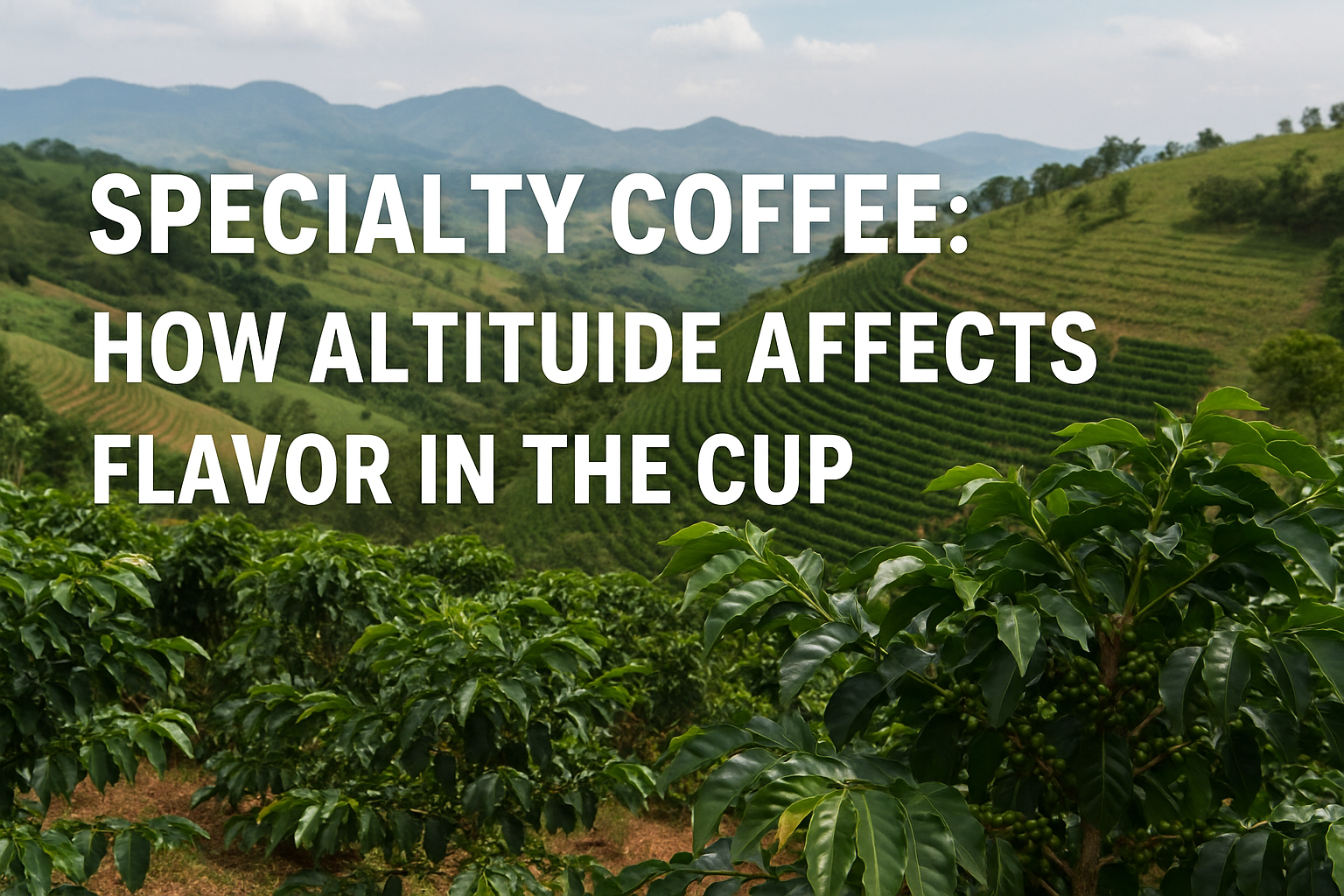In the world of specialty coffee, altitude is one of the most important factors influencing flavor.
If you’re training to become a barista or already working in a café, you’ve probably seen labels that mention the elevation where the coffee was grown — but why does that matter?
The truth is, altitude isn’t just a fancy detail. It directly affects the way coffee grows, ripens, and develops flavor. Understanding this helps you appreciate the work behind the beans and improves your ability to brew and explain the coffee you serve.
Let’s dive into how altitude shapes what ends up in your cup.
Why Altitude Matters in Coffee Growing
Coffee is a tropical crop, but it doesn’t like extreme heat. It thrives in specific conditions — moderate temperatures, rich soil, and regular rainfall. These conditions are often found at higher elevations.
Altitude affects two major things:
- Temperature: Higher elevations are cooler.
- Maturation speed: Cooler temperatures slow down how quickly the coffee cherry ripens.
Slower ripening allows the plant to develop more sugars and acids, which translates into more complex and refined flavors in the bean.
That’s why most high-scoring specialty coffees come from mountainous regions — the beans mature slowly, allowing time for nuance and clarity to develop.
Flavor Profiles by Altitude
As a barista, you’ll often see coffee labeled with its elevation, usually measured in meters above sea level (masl). Here’s what that number can tell you about flavor expectations:
Low Altitude (Below 900 masl)
- Faster maturation
- Lower acidity
- Heavier body
- Simpler flavor profile
These coffees tend to be strong, earthy, and full-bodied. You’ll find more Robusta grown at low elevations, as it tolerates heat and disease better than Arabica.
While not typically considered “specialty,” low-altitude coffees can still be enjoyable, especially in blends or for consumers who prefer bold, bitter profiles.
Mid-Altitude (900–1,200 masl)
- Balanced sweetness and body
- Moderate acidity
- Nutty or chocolaty notes
Coffees from this range are more balanced and versatile. They’re often used in espresso blends because they provide a rich base without overwhelming acidity.
High Altitude (1,200–1,800 masl)
- Bright acidity
- Complex flavor notes (fruits, florals, citrus)
- Lighter body
This is the sweet spot for many specialty coffees. The cooler environment leads to slower cherry development, allowing sugars to concentrate and acidity to refine.
You’ll often find award-winning coffees from regions like Ethiopia, Colombia, and Kenya grown at these altitudes.
Very High Altitude (Above 1,800 masl)
- Exceptional clarity
- Delicate floral or tea-like qualities
- Often washed or natural processed
These coffees are rare and harder to grow. They can be more expensive but offer some of the most unique and memorable flavors in the coffee world.
How Altitude Affects Bean Density
Another key impact of altitude is bean density. High-altitude coffee beans are denser because the plant grows more slowly. The cellular structure becomes more compact, which influences how the bean roasts and extracts.
Dense beans:
- Roast more evenly
- Hold complex flavors better
- Require careful brewing to avoid under-extraction
As a barista, knowing the density of your coffee helps you adjust grind size, temperature, and brew time more accurately.
Lower-density beans are softer and can roast quicker but may lack complexity. These are better suited for darker roasts or blends.
Altitude and Processing Methods
The elevation where coffee is grown also influences how it’s processed. In higher, cooler regions, it may take longer for beans to dry, so producers may favor washed processing to control fermentation.
In lower altitudes with hotter climates, natural or honey processing may be more common due to faster drying times.
Each method further shapes the final flavor, and the combination of altitude and processing creates an incredible diversity in the specialty coffee world.
Examples of High-Altitude Regions and Their Coffees
Let’s look at a few famous coffee-growing regions and how their altitude contributes to their signature flavors:
Ethiopia – 1,500 to 2,200 masl
- Light-bodied
- Floral and tea-like
- Bright, citrusy acidity
Ethiopian coffees, especially from Yirgacheffe or Sidamo, are famous for their high-altitude complexity. Often processed naturally, they offer a fruit-forward cup that’s delicate yet vibrant.
Colombia – 1,200 to 2,000 masl
- Balanced
- Sweet with red fruit and chocolate notes
- Medium body with clean acidity
Colombia’s Andes mountains provide ideal conditions for Arabica. Washed processing is common, giving the coffee clarity and structure.
Kenya – 1,400 to 1,900 masl
- Juicy acidity
- Notes of blackcurrant, tomato, and grapefruit
- Wine-like body
Kenyan coffees are known for their complexity and sharp acidity, partly due to the high altitude and rich volcanic soil.
Guatemala – 1,500 to 2,000 masl
- Full-bodied
- Cocoa and spice notes
- Balanced with crisp acidity
Antigua and Huehuetenango are two famous high-altitude regions producing consistently excellent beans.
Practical Tips for Baristas: Brewing High-Altitude Coffee
When working with high-altitude coffee, your brewing technique should aim to preserve the bean’s complexity and avoid over-extraction.
Here are a few tips:
- Use slightly lower water temperatures (88–92°C) to highlight acidity and brightness without making it too sharp.
- Choose pour-over or AeroPress to maintain clarity and control extraction.
- Use a finer grind, especially if the bean is particularly dense, to ensure full extraction of flavor.
Taste regularly and adjust based on the coffee’s origin and roast. Let your palate guide you.
How to Talk About Altitude With Customers
Most customers won’t ask about elevation — but when they see it on the bag or menu, they might be curious. This is your chance to share something valuable.
Instead of overwhelming them with technical data, keep it simple:
“This coffee is grown at high altitude, which means it has a cleaner, more complex flavor — you might taste notes of citrus or florals.”
Or:
“Because of the elevation where it was grown, this coffee has a bright acidity and a tea-like body. It’s really refreshing as a pour-over.”
Connecting flavor to origin makes the experience more meaningful and personal.
How Climate Change Is Affecting High-Altitude Coffee
Climate change poses a serious threat to high-altitude coffee production. Rising temperatures are pushing the ideal growing zones higher up the mountains — but those areas are limited.
As temperatures rise:
- Pests and diseases (like coffee leaf rust) move into higher zones.
- Harvest timing becomes less predictable.
- Quality may decline if beans mature too fast.
Some farmers are adapting by planting shade trees, experimenting with new varietals, or changing their harvest practices. Supporting high-altitude, sustainable farms helps preserve these unique flavors for future generations.
Conclusion: Altitude Is a Window Into Flavor
Altitude is more than just a number on a label — it’s a signal of what you can expect in your cup. The higher the elevation, the more likely you’ll find complex acidity, floral notes, and a cleaner, brighter profile.
As a barista, using this knowledge helps you:
- Choose the right brewing method
- Adjust your grind and water temperature
- Educate customers
- Appreciate the full story of the coffee
So next time you open a bag of beans, take a moment to check the elevation. It’s a small detail that tells a big part of the story — from the mountain to your mug.

Marcelo Rodrigues is a passionate barista with over 7 years of experience in specialty coffee. He’s worked in top cafés, led barista training sessions, and now shares practical tips to help beginners and coffee lovers improve their skills. Through this blog, Marcel makes the world of coffee more accessible—one cup at a time.

